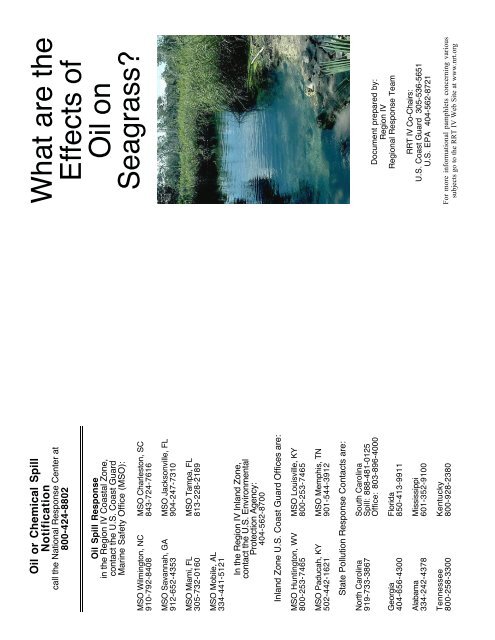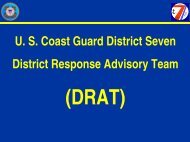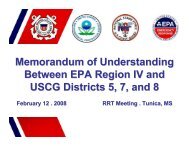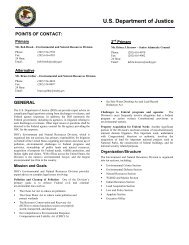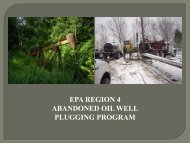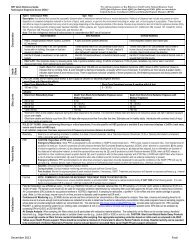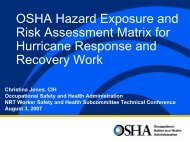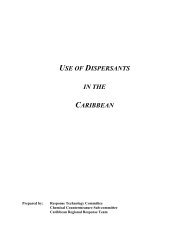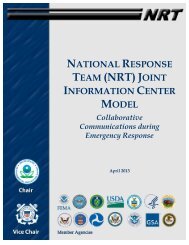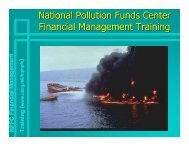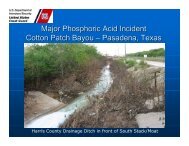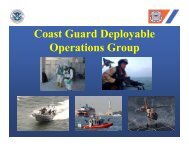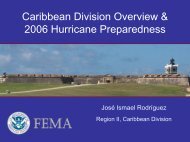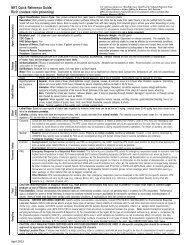What are the Effects of Oil on Seagrass? - U.S. National Response ...
What are the Effects of Oil on Seagrass? - U.S. National Response ...
What are the Effects of Oil on Seagrass? - U.S. National Response ...
- No tags were found...
Create successful ePaper yourself
Turn your PDF publications into a flip-book with our unique Google optimized e-Paper software.
<str<strong>on</strong>g>Oil</str<strong>on</strong>g> or Chemical SpillNotificati<strong>on</strong>call <str<strong>on</strong>g>the</str<strong>on</strong>g> Nati<strong>on</strong>al Resp<strong>on</strong>se Center at800-424-8802<str<strong>on</strong>g>Oil</str<strong>on</strong>g> Spill Resp<strong>on</strong>sein <str<strong>on</strong>g>the</str<strong>on</strong>g> Regi<strong>on</strong> IV Coastal Z<strong>on</strong>e,c<strong>on</strong>tact <str<strong>on</strong>g>the</str<strong>on</strong>g> U.S. Coast GuardMarine Safety Office (MSO):MSO Wilmingt<strong>on</strong>, NC MSO Charlest<strong>on</strong>, SC910-792-8408 843-724-7616MSO Savannah, GA MSO Jacks<strong>on</strong>ville, FL912-652-4353 904-247-7310MSO Miami, FL MSO Tampa, FL305-732-0160 813-228-2189MSO Mobile, AL334-441-5121In <str<strong>on</strong>g>the</str<strong>on</strong>g> Regi<strong>on</strong> IV Inland Z<strong>on</strong>e,c<strong>on</strong>tact <str<strong>on</strong>g>the</str<strong>on</strong>g> U.S. Envir<strong>on</strong>mentalProtecti<strong>on</strong> Agency:404-562-8700Inland Z<strong>on</strong>e U.S. Coast Guard Offices <str<strong>on</strong>g>are</str<strong>on</strong>g>:MSO Huntingt<strong>on</strong>, WV MSO Louisville, KY800-253-7465 800-253-7465MSO Paducah, KY MSO Memphis, TN502-442-1621 901-544-3912State Polluti<strong>on</strong> Resp<strong>on</strong>se C<strong>on</strong>tacts <str<strong>on</strong>g>are</str<strong>on</strong>g>:North Carolina South Carolina919-733-3867 Spill: 888-481-0125Office: 803-896-4000Georgia Florida404-656-4300 850-413-9911Alabama Mississippi334-242-4378 601-352-9100Tennessee Kentucky800-258-3300 800-928-2380<str<strong>on</strong>g>What</str<strong>on</strong>g> <str<strong>on</strong>g>are</str<strong>on</strong>g> <str<strong>on</strong>g>the</str<strong>on</strong>g><str<strong>on</strong>g>Effects</str<strong>on</strong>g> <str<strong>on</strong>g>of</str<strong>on</strong>g><str<strong>on</strong>g>Oil</str<strong>on</strong>g> <strong>on</strong><strong>Seagrass</strong>?Document prep<str<strong>on</strong>g>are</str<strong>on</strong>g>d by:Regi<strong>on</strong> IVRegi<strong>on</strong>al Resp<strong>on</strong>se TeamRRT IV Co-Chairs:U.S. Coast Guard 305-536-5651U.S. EPA 404-562-8721For more informati<strong>on</strong>al pamphlets c<strong>on</strong>cerning varioussubjects go to <str<strong>on</strong>g>the</str<strong>on</strong>g> RRT IV Web Site at www.nrt.org
<str<strong>on</strong>g>What</str<strong>on</strong>g> <str<strong>on</strong>g>are</str<strong>on</strong>g> <strong>Seagrass</strong>es?<strong>Seagrass</strong>es <str<strong>on</strong>g>are</str<strong>on</strong>g> found worldwide in shallow coastalwaters. Owing to <str<strong>on</strong>g>the</str<strong>on</strong>g> protecti<strong>on</strong> <str<strong>on</strong>g>the</str<strong>on</strong>g>y provide fromerosi<strong>on</strong>, <str<strong>on</strong>g>the</str<strong>on</strong>g>ir role in sediment accreti<strong>on</strong>, and <str<strong>on</strong>g>the</str<strong>on</strong>g>irprimary productivity, seagrasses <str<strong>on</strong>g>are</str<strong>on</strong>g> extremelyimportant. <strong>Seagrass</strong>es <str<strong>on</strong>g>are</str<strong>on</strong>g> unique because <str<strong>on</strong>g>the</str<strong>on</strong>g>y <str<strong>on</strong>g>are</str<strong>on</strong>g> landplants that have fully returned to <str<strong>on</strong>g>the</str<strong>on</strong>g> sea. Theyc<strong>on</strong>stitute <strong>on</strong>e <str<strong>on</strong>g>of</str<strong>on</strong>g> <str<strong>on</strong>g>the</str<strong>on</strong>g> most productive ecosystemsknown.High light levels <str<strong>on</strong>g>are</str<strong>on</strong>g> needed to sustain <str<strong>on</strong>g>the</str<strong>on</strong>g>ir high rate <str<strong>on</strong>g>of</str<strong>on</strong>g>productivity. As rooted plants <str<strong>on</strong>g>the</str<strong>on</strong>g>y also requiresediments for both attachment and nutriti<strong>on</strong>. Therefore,seagrasses <str<strong>on</strong>g>are</str<strong>on</strong>g> primarily found in shallow coastal waters.Because <str<strong>on</strong>g>of</str<strong>on</strong>g> <str<strong>on</strong>g>the</str<strong>on</strong>g>ir sediment stabilizati<strong>on</strong> and highproductivity functi<strong>on</strong>s, seagrasses tend to link <str<strong>on</strong>g>the</str<strong>on</strong>g>coastal and <str<strong>on</strong>g>of</str<strong>on</strong>g>fshore ecosystems.<strong>Seagrass</strong> EcologyAs photosyn<str<strong>on</strong>g>the</str<strong>on</strong>g>tic organisms, <str<strong>on</strong>g>the</str<strong>on</strong>g>y require high levels <str<strong>on</strong>g>of</str<strong>on</strong>g>light to sustain <str<strong>on</strong>g>the</str<strong>on</strong>g>ir high rate <str<strong>on</strong>g>of</str<strong>on</strong>g> productivity.However, as rooted plants <str<strong>on</strong>g>the</str<strong>on</strong>g>y require sediments forboth attachment and nutriti<strong>on</strong>. Thus, <str<strong>on</strong>g>the</str<strong>on</strong>g>y <str<strong>on</strong>g>are</str<strong>on</strong>g> restrictedto a narrow band <str<strong>on</strong>g>of</str<strong>on</strong>g> coastal waters where <str<strong>on</strong>g>the</str<strong>on</strong>g> <str<strong>on</strong>g>of</str<strong>on</strong>g>tenc<strong>on</strong>flicting demands <str<strong>on</strong>g>of</str<strong>on</strong>g> man <str<strong>on</strong>g>are</str<strong>on</strong>g> <str<strong>on</strong>g>the</str<strong>on</strong>g> greatest.<strong>Seagrass</strong>es provide many important functi<strong>on</strong>s in <str<strong>on</strong>g>the</str<strong>on</strong>g>aquatic envir<strong>on</strong>ment, including:• The leaves decrease current velocities <str<strong>on</strong>g>the</str<strong>on</strong>g>rebystabilizing sediments and increasing sedimentati<strong>on</strong><str<strong>on</strong>g>of</str<strong>on</strong>g> both organic and inorganic particles around <str<strong>on</strong>g>the</str<strong>on</strong>g>plants.• They bind toge<str<strong>on</strong>g>the</str<strong>on</strong>g>r to help stabilize <str<strong>on</strong>g>the</str<strong>on</strong>g> bottomstructure and reduce erosi<strong>on</strong>. Their hold to <str<strong>on</strong>g>the</str<strong>on</strong>g>bottom is so effective that <str<strong>on</strong>g>the</str<strong>on</strong>g>y can persist through150 kt winds during hurricanes.• Nutriti<strong>on</strong> for many organisms throughout <str<strong>on</strong>g>the</str<strong>on</strong>g> foodchain.• The leaves support large numbers <str<strong>on</strong>g>of</str<strong>on</strong>g> epiphyticorganisms, with a total biomass which <str<strong>on</strong>g>of</str<strong>on</strong>g>tenapproaches that <str<strong>on</strong>g>of</str<strong>on</strong>g> <str<strong>on</strong>g>the</str<strong>on</strong>g> plants <str<strong>on</strong>g>the</str<strong>on</strong>g>mselves.<strong>Seagrass</strong>es <str<strong>on</strong>g>are</str<strong>on</strong>g> positi<strong>on</strong>ed in <str<strong>on</strong>g>the</str<strong>on</strong>g> coastal z<strong>on</strong>e betweenupland ecosystems and <str<strong>on</strong>g>the</str<strong>on</strong>g> <str<strong>on</strong>g>of</str<strong>on</strong>g>fshore oceanic ecosystem.As a result <str<strong>on</strong>g>of</str<strong>on</strong>g> <str<strong>on</strong>g>the</str<strong>on</strong>g>ir sediment stabilizati<strong>on</strong> and highproductivity functi<strong>on</strong>s, seagrasses tend to link <str<strong>on</strong>g>the</str<strong>on</strong>g>seo<str<strong>on</strong>g>the</str<strong>on</strong>g>rwise dissimilar ecosystems. <strong>Seagrass</strong> ecosystems<str<strong>on</strong>g>are</str<strong>on</strong>g> comparable to saltmarsh ecosystems in that <str<strong>on</strong>g>the</str<strong>on</strong>g>y trapmaterials and export quantities <str<strong>on</strong>g>of</str<strong>on</strong>g> plant and animalproducts to <str<strong>on</strong>g>the</str<strong>on</strong>g> open sea. These products range fromwhole leaves and stems, to detritus, to dissolved organicmatter, and to fauna that have c<strong>on</strong>sumed <str<strong>on</strong>g>the</str<strong>on</strong>g>se plants.The depth distributi<strong>on</strong> <str<strong>on</strong>g>of</str<strong>on</strong>g> seagrass depends <strong>on</strong> a number<str<strong>on</strong>g>of</str<strong>on</strong>g> interrelated factors: light penetrati<strong>on</strong>, turbidity,substrate, currents, and waves. Any activity thatincreases turbidity or reduces light penetrati<strong>on</strong> in waterover seagrasses limits <str<strong>on</strong>g>the</str<strong>on</strong>g> growth and survival <str<strong>on</strong>g>of</str<strong>on</strong>g> <str<strong>on</strong>g>the</str<strong>on</strong>g>plants. Am<strong>on</strong>g human-related factors that have suchimpacts <str<strong>on</strong>g>are</str<strong>on</strong>g> dredging, sewage release, and oil polluti<strong>on</strong>.Susceptibility Of <strong>Seagrass</strong> Ecosystems To<str<strong>on</strong>g>Oil</str<strong>on</strong>g> DamageThe potential for damage to seagrass ecosystems can bebroken down into two broad categories: susceptibilityand vulnerability. Susceptibility is taken to be <str<strong>on</strong>g>the</str<strong>on</strong>g>potential for damage to <str<strong>on</strong>g>the</str<strong>on</strong>g> plants and associatedcommunities due to c<strong>on</strong>tact with oil or oil-relatedchemicals, ei<str<strong>on</strong>g>the</str<strong>on</strong>g>r breakdown products or cleanupchemicals. In particular, certain comp<strong>on</strong>ents <str<strong>on</strong>g>of</str<strong>on</strong>g> bothcrude and refined products have high toxicity to marineorganisms in small c<strong>on</strong>centrati<strong>on</strong>s. By comparis<strong>on</strong>,vulnerability is largely a positi<strong>on</strong>al effect, reflecting <str<strong>on</strong>g>the</str<strong>on</strong>g>proximity <str<strong>on</strong>g>of</str<strong>on</strong>g> a particular grass bed to a potential hazard.<strong>Seagrass</strong> beds <str<strong>on</strong>g>are</str<strong>on</strong>g> especially vulnerable to damage anddegradati<strong>on</strong> by human activities because <str<strong>on</strong>g>of</str<strong>on</strong>g> <str<strong>on</strong>g>the</str<strong>on</strong>g>ir locati<strong>on</strong>in <str<strong>on</strong>g>the</str<strong>on</strong>g> shallow coastals seas where activities <str<strong>on</strong>g>of</str<strong>on</strong>g> man <str<strong>on</strong>g>are</str<strong>on</strong>g>greatest. The potential for damage is highest in grassbeds within harbors, estuaries, and lago<strong>on</strong>s, and in <str<strong>on</strong>g>are</str<strong>on</strong>g>asin close proximity to shipping lanes.Petroleum products can act to damage seagrassaecosystems in a variety <str<strong>on</strong>g>of</str<strong>on</strong>g> ways, including:• Direct mortality <str<strong>on</strong>g>of</str<strong>on</strong>g> organisms due to smo<str<strong>on</strong>g>the</str<strong>on</strong>g>ring,fouling, asphyxiati<strong>on</strong> or pois<strong>on</strong>ing.• Indirect mortality due to <str<strong>on</strong>g>the</str<strong>on</strong>g> death <str<strong>on</strong>g>of</str<strong>on</strong>g> food sourcesor <str<strong>on</strong>g>the</str<strong>on</strong>g> destructi<strong>on</strong> or removal <str<strong>on</strong>g>of</str<strong>on</strong>g> habitat.• Destructi<strong>on</strong> <str<strong>on</strong>g>of</str<strong>on</strong>g> juveniles using grass beds as anursery ground.• Incorporati<strong>on</strong> <str<strong>on</strong>g>of</str<strong>on</strong>g> sublethal amounts <str<strong>on</strong>g>of</str<strong>on</strong>g> petroleumfracti<strong>on</strong>s into body tissues, potentially loweringtolerance to o<str<strong>on</strong>g>the</str<strong>on</strong>g>r stresses.• Reducti<strong>on</strong> or destructi<strong>on</strong> <str<strong>on</strong>g>of</str<strong>on</strong>g> <str<strong>on</strong>g>the</str<strong>on</strong>g> food or marketvalue <str<strong>on</strong>g>of</str<strong>on</strong>g> fisheries due to absorpti<strong>on</strong> <str<strong>on</strong>g>of</str<strong>on</strong>g>hydrocarb<strong>on</strong>s.• Incorporati<strong>on</strong> <str<strong>on</strong>g>of</str<strong>on</strong>g> potentially carcinogenic ormutagenic substances into <str<strong>on</strong>g>the</str<strong>on</strong>g> food chain.


